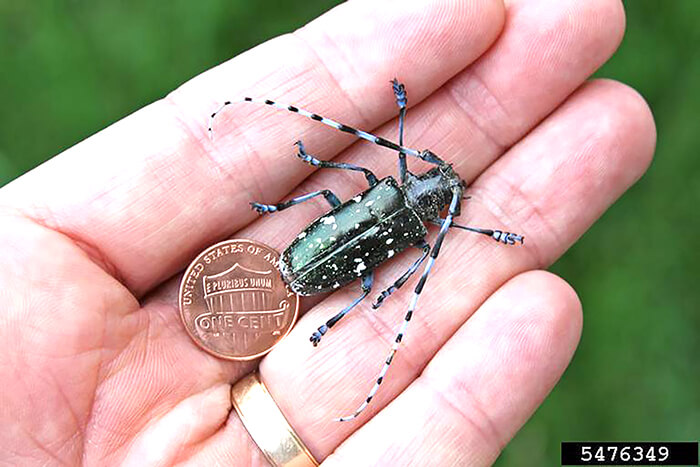August 11, 2017
Destructive pests: Check your trees for Asian long-horned beetles

Purdue entomologist request Indiana residents check their trees for signs of the Asian long-horned beetle and report if sighted. (Phot/Joe Boggs, Ohio State University)
WEST LAFAYETTE, Ind. – August is peak emergence season for the invasive Asian long-horned beetle, a pest that poses a serious threat to shade trees. A Purdue University entomologist is urging people to perform their annual tree checkup for these destructive insects. In just a few minutes, people can determine if their trees are infested and save countless other trees through early detection.
This month is designated “Tree Check Month” by the U.S. Department of Agriculture’s Animal and Plant Health Inspection Service, or APHIS. The Asian long-horned beetle has not been found in Indiana yet, but it has been found nearby in Chicago and Ohio.
“If you see an Asian long-horned beetle, you should report it,” said Cliff Sadof, a Purdue professor of entomology. “Early reports by private citizens have been critical to eradication efforts in Chicago, Ohio, New York and New Jersey.”
To report the beetle, Sadof recommends calling 1-866-NO-EXOTIC. Smartphone apps also are available at https://apps.bugwood.org/apps/gledn/, where citizens can report suspected beetle infestations. Reports go to the state first and then to Purdue for confirmation.
The Tree Doctor App, which is available at Purdue Extension’s The Education Store at www.edustore.purdue.edu, can also be used to identify this beetle and other common tree pests.
The Asian long-horned beetle is a distinctive-looking insect with these characteristics:
- Body is about 1 inch to 1 inch and a half in length.
- Antennae, longer than the insect’s body, is banded in black and white.
- Shiny jet black body that features random white spots.
- Six legs, in some cases with bluish-colored feet.
Signs of an infestation start to show about three to four years after the tree is infested. Such trees show these signs:
- Dime-sized or smaller round exit holes in the tree trunk or branches.
- Shallow oval or round scars in the bark, where the adult beetle has chewed an egg site.
- Sawdust-like materials, called frass, on the ground around the tree or on the branches.
- Dead branches or limbs falling from an otherwise healthy-looking tree.
Asian long-horned beetles also commonly fall into swimming pools. Sadof suggests residents check their water skimmers for the beetle, too.
APHIS reports that maples are the most commonly infested trees in North America. Infested trees do not recover and, therefore, should be removed.
Writer: Morgan Sussman, msussman@purdue.edu
Source: Cliff Sadof, csadof@purdue.edu
Media contact: Shari Finnell, sfinnell@purdue.edu, 765-494-2722
Agricultural Communications: (765) 494-8415;
Shari Finnell, Manager/Media Relations and Public Information, sfinnell@purdue.edu
Agriculture News Page

